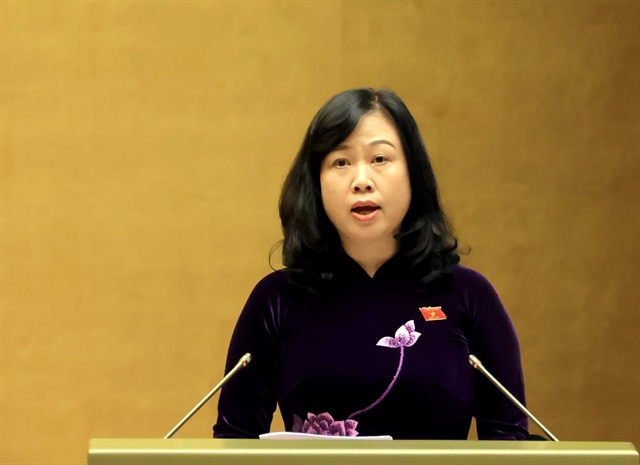 Politics & Law
Politics & Law

 |
| Minister of Health Đào Hồng Lan speaks at the session. — VNA/VNS Photo Tuấn Anh |
HÀ NỘI — Minister of Health Đào Hồng Lan presented the draft Population Law to the National Assembly on Thursday morning, aiming to update policies, address population challenges and improve the legal framework in response to demographic changes.
The draft law was developed to institutionalise the Party's policies on population work in the new context while addressing limitations of the previous ordinance. Its objectives are to establish a unified legal foundation, protect the legitimate rights and interests of individuals and organisations, and ensure compatibility with international treaties to which Việt Nam is a signatory.
Compared with the 2003 Ordinance, the draft law abolishes 26 articles, revises 10, amends one and adds 15 new provisions. New content focuses on communication and advocacy, adjusting population size and structure, and improving population quality. The draft is expected to comprise eight chapters and 28 articles.
The law covers key issues such as maintaining the replacement fertility rate, reducing gender imbalance at birth, adapting to population aging, improving population quality and ensuring conditions for population work. It introduces specific policies and measures.
To maintain the replacement fertility rate, the draft proposes extending maternity leave, providing financial support for childbirth and prioritising certain families for purchasing or renting social housing. To address gender imbalance at birth, it prohibits fetal sex selection except for diagnosing sex-linked genetic disorders and stipulates strict penalties for medical practitioners who disclose fetal sex information to clients.
Minister Lan highlighted solutions to support elderly care, develop human resources for caregiving and protect the elderly from rights violations amid population aging. Measures to improve population quality include pre-marital health counselling and strengthened prenatal and newborn screening, diagnosis and treatment.
In response to deputies’ questions, Minister Lan noted that population issues have long been addressed in Party and State documents, most recently in Politburo Resolution No. 72-NQ/TW, which provides significant policy guidelines. Population policies have primarily been implemented under the Ordinance on Population, but the aging population and declining fertility rates require urgent action. The Ministry of Health has been tasked with reviewing, amending and supplementing regulations accordingly.
The draft law also proposes expanding social housing support for families with two children. Currently, priority is given to families of people with meritorious services, relatives of martyrs, persons with disabilities and those resettled by the State.
“We propose adding families where women have given birth to two children or men with two biological children whose wives have passed away. The goal is to help families with two children have more stable living conditions,” Minister Lan said.
Adapting to aging population
Chairman of the NA’s Committee for Culture and Social Affairs Nguyễn Đắc Vinh emphasised finalising the draft law, particularly regarding sustainable fertility and adapting to aging. The law should institutionalise the shift from family planning to population and development, ensuring consistency with the Constitution, existing laws and international treaties.
The committee recommended a separate article outlining a comprehensive framework covering housing, education and healthcare. To maintain sustainable fertility, it suggested researching holistic measures, offering financial support for women with two children and prioritising access to social housing. Additional recommendations include supporting infertility treatment and reducing abortion rates.
Given rapid aging, the report proposed renaming Chapter 4 to 'Adapting to Population Aging' and adding regulations to develop diverse elderly care forms. Regarding gender imbalance, the law should allow the Government to periodically report provinces and cities with very high imbalances for intervention measures. The draft also clarifies methods for pre-marital health counselling and newborn disease screening to enhance population quality. — VNS




